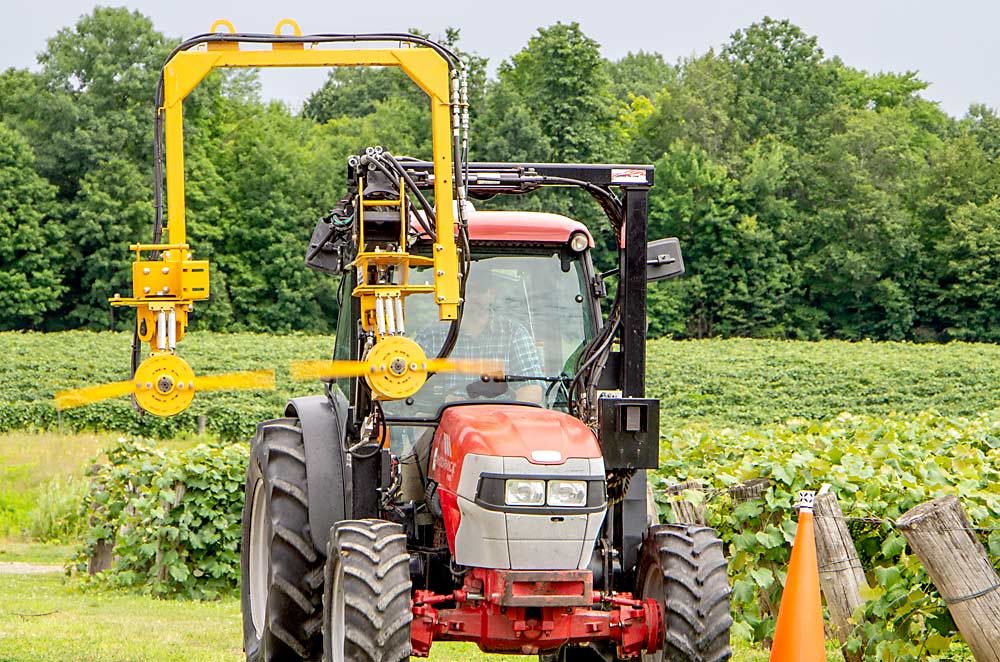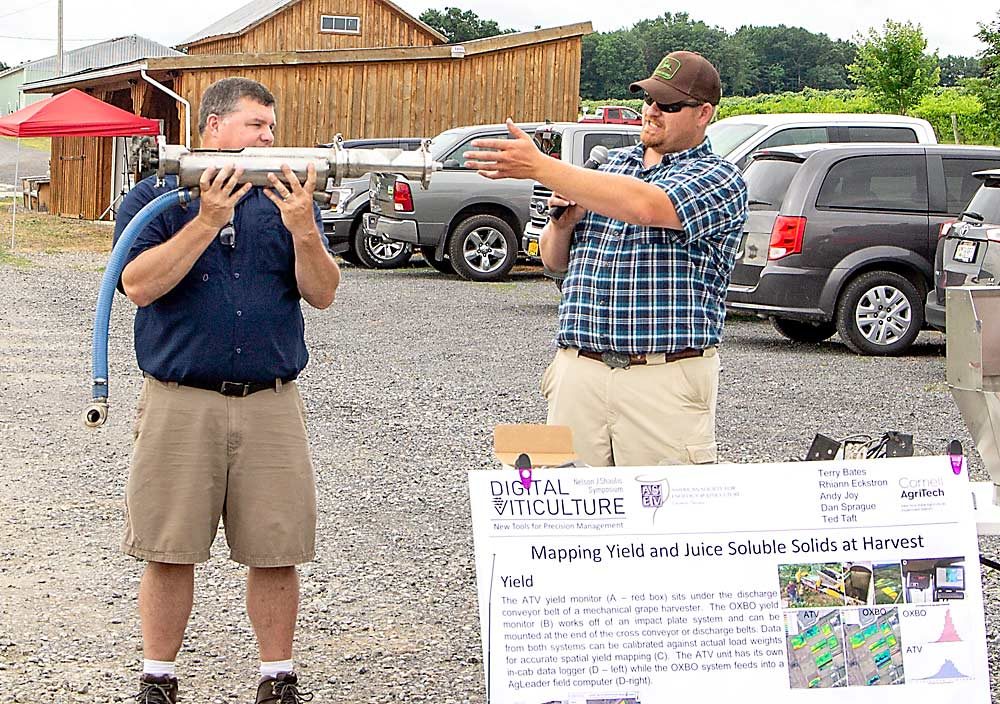
Row crop growers are way ahead of specialty crop producers when it comes to the technology for variable-rate management, but with a few simple tweaks, those tools can be hijacked to make variable-rate vineyard management possible, too.
Take, for example, an Ag Leader field computer running on a vineyard tractor with a shoot thinning arm.
“It thinks it is applying a gallon per minute rate. It thinks it’s a sprayer, but we tricked it to run rotations per minute instead,” said Andy Joy, research technician for the Cornell Cooperative Extension’s Lake Erie Regional Grape Program.
For the past four years, researchers there have been collaborating with colleagues in spatial data and computer learning to develop tools for variable-rate vineyard management through a federally funded effort known as the Efficient Vineyard project.
Joy demonstrated how the spinning arms automatically adjust based on the GPS coordinates as the tractor moved through different zones of vineyard productivity at the Digital Viticulture field day in the Finger Lakes region of New York. The field day was organized by the American Society for Enology and Viticulture’s Eastern Section for its annual meeting.
The automatically adjusting shoot thinner is just the visible result of layers of maps and data analysis, said Terry Bates, director of the Lake Erie lab and leader of the Efficient Vineyard effort. Maps of soil electrical conductivity (EC) and normalized difference vegetation index (NDVI) — maps that growers are likely familiar with but not always sure how to use — create the foundation for the approach.
“For someone not trained in spatial analysis, more data doesn’t always make things easier,” said James Taylor, a spatial data scientist with Newcastle University and partner on the project. “What we were missing is ways to make decisions with this data. We need to get the information from farmers’ heads into the data analysis.”
The project team is developing a web-based platform that growers can use to upload the spatial data gathered about their vineyard — from EC and NDVI maps, or perhaps yield maps from a harvester with a yield monitor — and run the analysis using the software built by Taylor and his colleagues.
“You can take that magic behind the scenes, thank you James, and get your prescription map,” said research technician Jennifer Russo, who showed the web platform to attendees of the field day. (Visit the web platform at my.efficientvineyard.com)
Recommendations for variable-rate nitrogen applications or thinning prescriptions can be tailored to each vineyard’s operations and goals, Bates added. Lots of details about how to apply the project’s findings can be found on the project webpage.
Clearview Farms, along Keuka Lake, hosted the demo. Owners Harold and Don Tones grow 600 acres of grapes, including Concord, Aurora, Riesling and cold-hardy hybrids.
Using the variable-rate management approach, with soil and NDVI maps to guide nutrient inputs, is already paying off for the farm, they said.
“We didn’t really save any money, but we put the money in the right place,” Don Tones said. “It evened the vineyards right up and we saw a huge improvement.”
Now, they are interested in adding variable-rate shoot thinning and fruit thinning to the mix to reduce hand labor needs and improve vineyard performance, Harold Tones said.
For the Efficient Vineyard project, the first goal of the project was to develop these tools growers need to efficiently deploy variable-rate management, Bates said. Now, they plan to move into multiyear trials with commercial partners.
They also began using sensors to assess fruit quality, so that it could be spatially mapped similar to yield maps gathered during harvest. Joy and Bates showed off the iteration, now in development, of a system that collected free-run juice and ran it past a refractometer designed for on-the-go Brix monitoring in manufacturing facilities.

As a proof-of-concept, it worked, with a Brix map being built as the harvester worked the vineyard. However, for more consistency, they need to develop a better way to get clean juice past the sensor, Joy said.
Once that’s working well, any number of juice quality sensors could be added, Bates said.
Such a system could open the door to field sorting during harvest with a double-bin machine, Joy said.
The second half of the field day featured more ideas for innovative vineyard technology, including:
—Miniature weather sensors that could capture microclimate variations and beep back data every 15 minutes to alert wind machines to frost risk or if canopy conditions reach a disease management threshold. Cornell graduate student Hunter Adams is studying the potential applications of the low-cost sensors in vineyards, including Anthony Road Vineyard along Seneca Lake, which hosted the afternoon presentations.
—A drone equipped with an NDVI camera so sophisticated it basically flies itself.
—A high-powered camera and computer system that can be attached to a tractor and driven through a vineyard to assess crop load with machine learning algorithms. It works well in VSP-trained vineyards, where clusters are more exposed from the canopy, said lead engineer George Kantor from Carnegie Mellon University.
—An alternative crop load assessment technique using a smartphone-based application to simply count clusters. The technology is being developed by Cornell viticulturist Justine Vanden Heuvel and electrical engineering student Jonathan Jaramillo.
—A microtensiometer that can detect water pressure changes inside a vine or tree trunk to measure plant water stress throughout the day. The soon-to-be-commercialized technology will allow for precision irrigation tailored directly to plant needs, not via soil assessments or clunky pressure chamber tests, said Cornell physiologist Alan Lakso. •
—by Kate Prengaman
Related:
—Tools for counting the crop






Leave A Comment